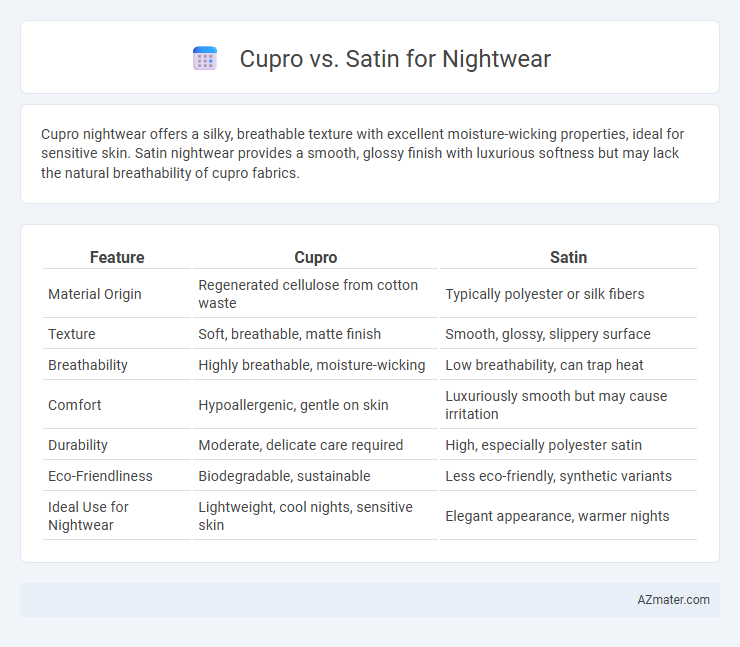Cupro nightwear offers a silky, breathable texture with excellent moisture-wicking properties, ideal for sensitive skin. Satin nightwear provides a smooth, glossy finish with luxurious softness but may lack the natural breathability of cupro fabrics.
Table of Comparison
| Feature | Cupro | Satin |
|---|---|---|
| Material Origin | Regenerated cellulose from cotton waste | Typically polyester or silk fibers |
| Texture | Soft, breathable, matte finish | Smooth, glossy, slippery surface |
| Breathability | Highly breathable, moisture-wicking | Low breathability, can trap heat |
| Comfort | Hypoallergenic, gentle on skin | Luxuriously smooth but may cause irritation |
| Durability | Moderate, delicate care required | High, especially polyester satin |
| Eco-Friendliness | Biodegradable, sustainable | Less eco-friendly, synthetic variants |
| Ideal Use for Nightwear | Lightweight, cool nights, sensitive skin | Elegant appearance, warmer nights |
Introduction to Cupro and Satin Fabrics
Cupro is a regenerated cellulose fiber derived from cotton linter, known for its silky texture, breathability, and moisture-wicking properties, making it ideal for comfortable nightwear. Satin, a weave rather than a fiber, can be made from silk, polyester, or nylon, characterized by its smooth, glossy surface and luxurious drape, often chosen for its elegant appearance in sleepwear. Both fabrics offer distinct benefits: Cupro emphasizes natural breathability and softness, while satin provides a sleek, shiny finish that enhances nighttime aesthetics.
Origins and Fabric Composition
Cupro is a regenerated cellulose fiber derived from cotton linter, known for its silk-like softness and breathability, making it a luxurious choice for nightwear. Satin is a weaving technique rather than a fiber, commonly made from silk, polyester, or nylon, producing a glossy, smooth surface ideal for elegant nightwear. The natural origin of Cupro contrasts with satin's varied fiber sources, affecting breathability and comfort in nightwear fabrics.
Texture and Feel Against the Skin
Cupro offers a silky-smooth texture with excellent breathability, making it gentle and cooling against the skin, ideal for sensitive or warm sleepers. Satin, known for its glossy, sleek finish, provides a luxurious and smooth feel but can sometimes trap heat, which may cause discomfort for those prone to night sweating. Both fabrics enhance nightwear comfort, but Cupro's natural fibers often deliver superior softness and moisture-wicking properties compared to synthetic or blended Satin.
Breathability and Moisture Wicking
Cupro fabric offers superior breathability and moisture-wicking properties compared to satin, making it ideal for nightwear that keeps you cool and dry throughout the night. Derived from regenerated cellulose fibers, Cupro allows air to circulate freely and effectively absorbs moisture, preventing discomfort caused by sweat. Satin, often made from synthetic fibers or silk, has a smoother texture but lacks the same level of ventilation and moisture management, potentially leading to a warmer sleep experience.
Durability and Longevity
Cupro nightwear offers excellent durability due to its strong, regenerated cellulose fibers that resist pilling and retain shape over time, ensuring long-lasting wear. Satin, often made from silk or polyester, provides a smooth finish but may be more prone to snags and wear, especially with frequent washing. Choosing cupro ensures nightwear maintains its integrity and appearance longer, making it a superior option for durability and longevity.
Sustainability and Eco-Friendliness
Cupro, a regenerated cellulose fiber derived from cotton linter, stands out for its biodegradability and minimal chemical usage in production, making it a highly sustainable choice for nightwear. Satin, often crafted from synthetic fibers like polyester, tends to have a larger environmental footprint due to fossil fuel dependence and slower decomposition rates. Choosing cupro nightwear supports eco-friendly fashion by reducing plastic waste and promoting renewable natural resources.
Aesthetic Appeal and Shine
Cupro nightwear offers a luxurious matte finish with a subtle sheen that exudes elegance and sophistication, ideal for those who prefer understated glamour. Satin nightwear boasts a high-gloss, reflective shine that enhances the garment's fluidity and visual appeal, creating a glamorous and seductive look. Both fabrics elevate nightwear aesthetics, with cupro providing a soft, natural sheen and satin delivering an unmistakable glossy brilliance.
Comfort in Different Seasons
Cupro, made from regenerated cellulose fibers, offers excellent breathability and moisture-wicking properties, making it ideal for keeping cool and comfortable in warm summer nights. Satin, often crafted from silk or polyester, provides a smooth, luxurious feel but can trap heat, making it better suited for cooler seasons or air-conditioned environments. Both fabrics deliver softness against the skin; however, Cupro's natural breathability enhances comfort during humid conditions, while Satin's insulating quality supports warmth during colder months.
Maintenance and Care Instructions
Cupro nightwear requires gentle hand washing in cool water with mild detergent to maintain its smooth, silk-like texture and prevent fabric weakening. Satin nightwear, particularly polyester satin, benefits from machine washing on a delicate cycle with cold water, but silk satin demands dry cleaning or careful hand washing to avoid fabric damage. Both fabrics should be air-dried away from direct sunlight to preserve their color and sheen, and ironing should be done on low heat with a protective cloth to prevent scorching.
Price Comparison and Value
Cupro nightwear tends to be more expensive than satin due to its sustainable production and breathable, silk-like texture, offering better moisture absorption and comfort. Satin, often made from polyester or silk, presents a lower price point with a smooth, shiny finish but may lack Cupro's eco-friendly qualities and breathability. The value of Cupro lies in its durability and natural fibers, making it a worthwhile investment for long-term use, while satin appeals to budget-conscious buyers seeking affordable elegance.

Infographic: Cupro vs Satin for Nightwear
 azmater.com
azmater.com